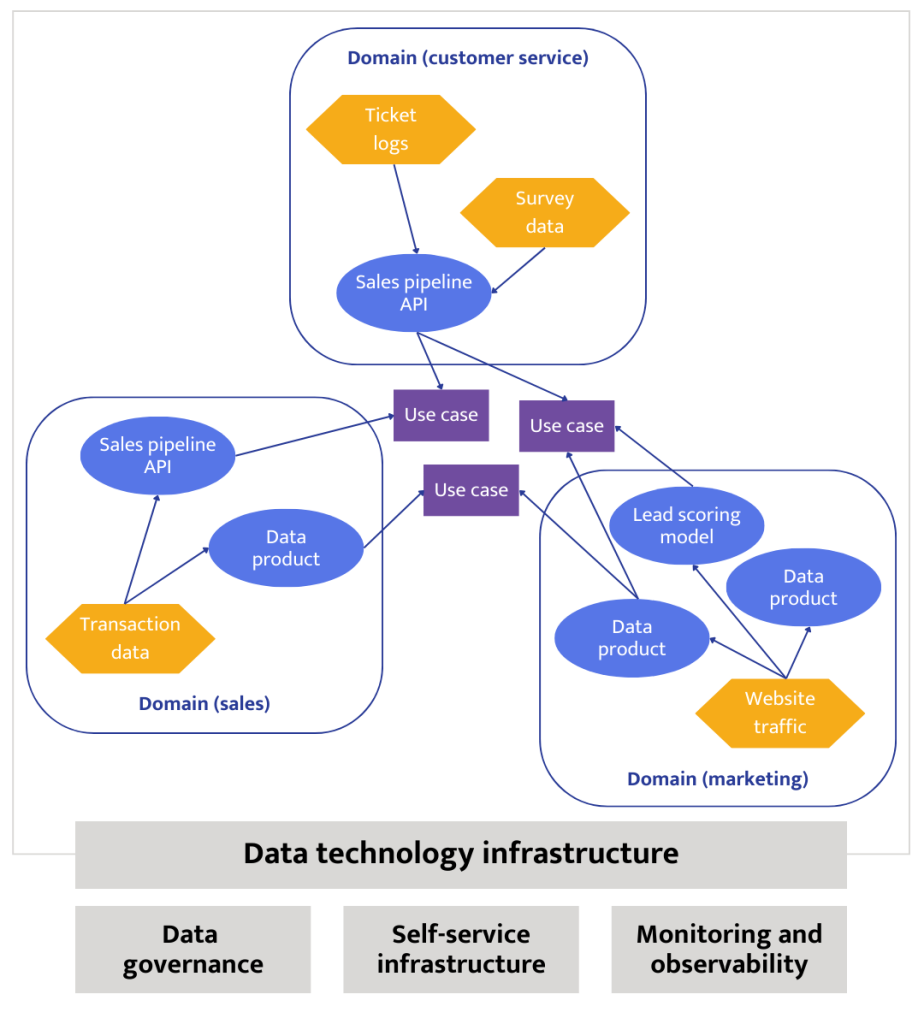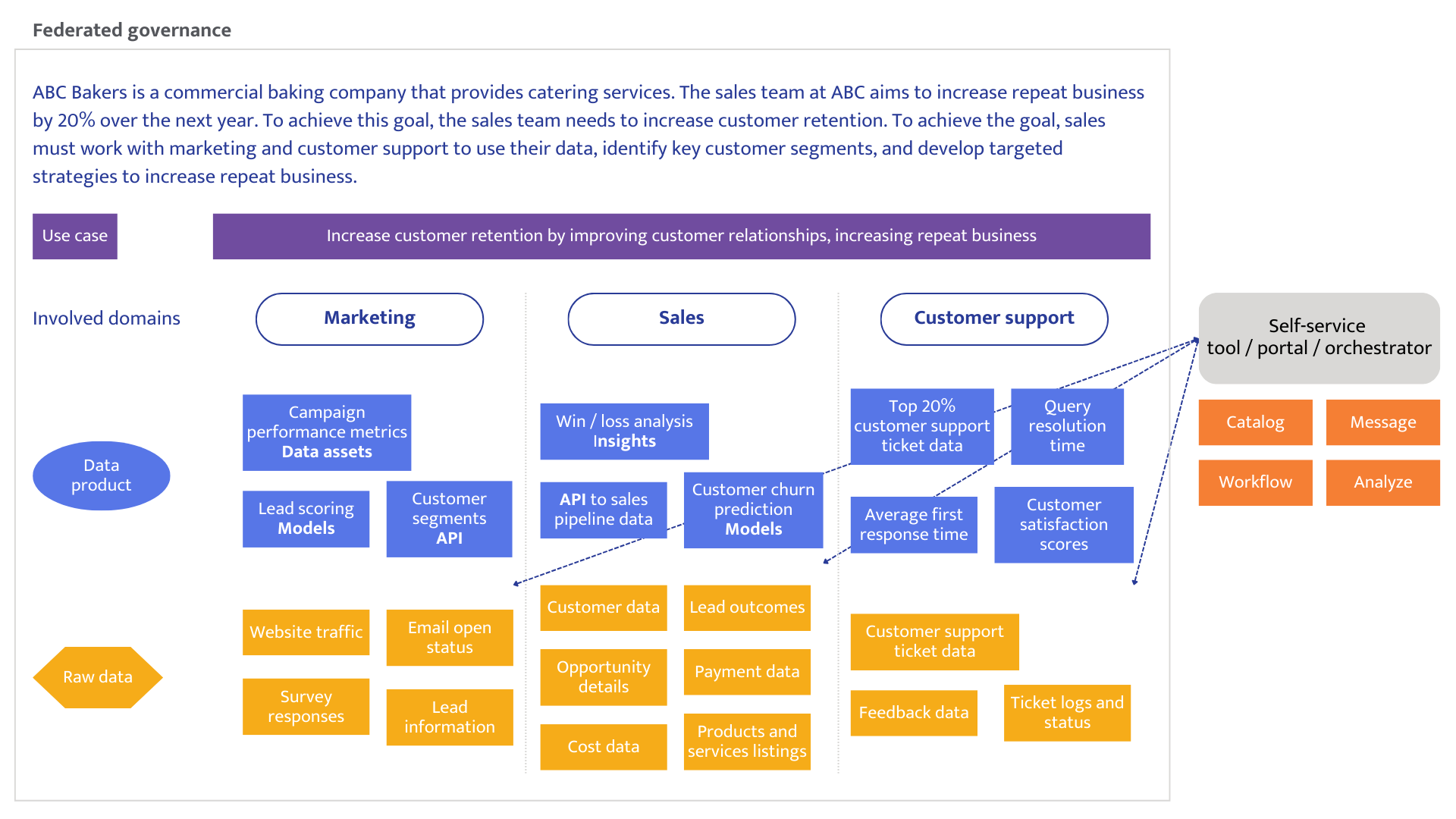
Data mesh has been gaining traction among organizations as they seek more scalable, decentralized data architectures. At its core, data mesh breaks away from traditional, centralized data architectures by focusing on domain-driven ownership.
However, the approach isn’t a one-size-fits-all solution, and it’s crucial to identify the scenarios where a data mesh architecture makes sense. Let’s explore the basics of data mesh, when it’s the right fit for your organization, how data products and data mesh fit together, and what real-world implementations look like in action.
To begin, understanding the inspiration behind the data mesh architecture is essential. Over the past two decades, some of the world’s most successful companies – businesses like Airbnb and Uber – have built their businesses by connecting producers with consumers through data-driven platforms. Their success is rooted in network orchestration, characterized by a focus on user experience, enabling tools for transactions, and leveraging data to aggregate supply and demand. However, a critical but lesser-known aspect of their success is their use of domain-driven design, which rejects monolithic architectures in favor of focusing on distinct business domains.
This principle of domain-driven design influenced the creation of the data mesh architecture in 2019, spearheaded by Zhamak Dehghani. Data mesh embraces decentralized data ownership, treating data as a product and establishing autonomous domains responsible for their own data. It’s important to note that data mesh is not a product or a piece of technology. Instead, it comprises four key principles, each essential to understanding how the architecture functions.
The data mesh methodology is particularly beneficial for companies with dedicated domain data and analytics teams, allowing them to foster ownership and prioritize end users in their data-driven initiatives. For successful implementation, strong executive support and a long-term commitment to strategic transformation are essential, especially for those that have historically struggled to scale centralized data models in response to increasing data volumes and diversity.
Organizations with advanced technological infrastructures and engineering practices can utilize data mesh to enhance scalability and improve data quality, all while implementing granular security controls at the data product level. Additionally, a decentralized governance framework empowers domain teams to operate more independently, facilitating agility alongside centralized policy enforcement. Ultimately, organizations that can dedicate the necessary resources and maintain a long-term vision find that adopting data mesh principles can significantly enhance their data management capabilities.
While the data mesh approach offers significant benefits for many organizations, it may not be suitable for all. Small organizations with limited data and analytics resources might find that a centralized data team serves their needs more efficiently, while extremely large and complex organizations could struggle with the added overhead and coordination challenges that data mesh introduces. Additionally, a lack of a clear data strategy or low data maturity can hinder successful implementation; organizations must possess a defined vision, measurable goals, and advanced data engineering practices to navigate the complexities of data mesh effectively.
Cultural factors also play a crucial role. Organizations that rely on top-down decision-making or lack cross-functional, domain-oriented teams may find it difficult to adopt this decentralized model. Furthermore, sufficient talent and resources are essential, as data mesh requires a commitment to long-term development rather than short-term fixes. Ultimately, organizations that do not prioritize analytical focus or data product development processes may discover that data mesh is misaligned with their business needs, making it a less effective choice for their data management strategy.
Let’s take a look at a simplified example of a data mesh architecture that highlights essential components working together. It demonstrates how different teams can independently manage their data while ensuring it’s discoverable and reusable across the organization, fostering seamless collaboration and innovation.
 (In this image, you will see a simplified sample layout of data mesh framework with key elements)
(In this image, you will see a simplified sample layout of data mesh framework with key elements)
In this example, you will notice:
Let’s take a look at the structured breakdown of a real-world scenario, highlighting how a data mesh architecture contributes to cross-domain use cases and empowers teams to leverage each other’s data products within the organization.
 (In the image, you will see how data products from each domain are made available for use across the organization, demonstrating the power of data mesh)
(In the image, you will see how data products from each domain are made available for use across the organization, demonstrating the power of data mesh)
In the scenario described, you can see how a data mesh framework facilitates seamless collaboration across domains—in this example, sales, marketing, and customer support—within an organization. Each team operates with decentralized ownership of its own data products, which are made accessible through a self-service orchestrator. For example:
This setup eliminates the need for lengthy processes, such as going through centralized IT, and allows teams to directly access the data they need, speeding up the execution of business initiatives.
By using a self-service platform or orchestrator, each team can easily discover, request, and integrate data products from other domains, enabling cross-domain use cases. Teams can collaborate, share insights, and use data more efficiently to achieve their common goal—in this case, increasing repeat business.
By decentralizing data management and empowering individual domains, data mesh helps businesses overcome the inefficiencies of traditional data frameworks. Organizations can achieve greater agility, as teams are no longer waiting for central data teams to fulfill requests. They can also scale faster, as each domain can evolve its own data products without affecting others.
Moreover, by treating data as a product and ensuring strong governance through a federated model, businesses can achieve higher data quality, better decision-making, and improved compliance. As data becomes more accessible and reliable, organizations can leverage insights to drive innovation, optimize operations, and maintain a competitive edge.
Overall, data mesh offers a powerful framework for modernizing data management, aligning business and IT goals, and unlocking the full value of enterprise data. If you’d like to tap into the full potential of your data with a decentralized, scalable approach, get in touch with Wavicle. Our expertise in data mesh can help you modernize your data management and build a data ecosystem that works for you.